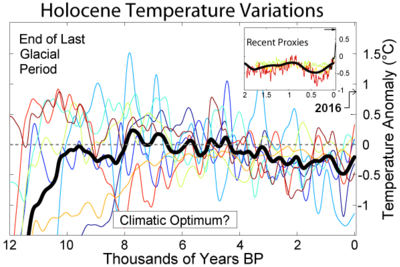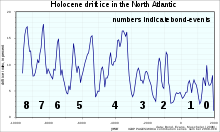Événement de Bond

Un évènement de Bond est un phénomène de lâcher massif d'icebergs dans l'Atlantique Nord, identifié grâce aux dépôts de sédiments laissés par la glace sur les fonds marins une fois fondue, autrement appelé un transport par radeaux de glace[1],[note 1]. Ces évènements sont peut-être en lien avec certaines fluctuations climatiques de l'Holocène. Les évènements de Bond sont, à l'Holocène, l'équivalent des évènements de Dansgaard–Oeschger du Pléistocène[2].
Historique
[modifier | modifier le code]Gerard C. Bond, du Lamont-Doherty Earth Observatory de l'Université Columbia, était l'auteur principal d'un article en 1997, dans lequel il posait la théorie de l'existence d'un cycle climatique de 1 470 ans à la fin du Pléistocène et au début de l'Holocène. L'hypothèse était principalement fondée sur l'étude de traceurs pétrologiques dans des carottes prélevées dans les fonds marins de l'océan Atlantique Nord[3],[4].
Les supposés lâchers massifs d'icebergs dans l'Atlantique Nord ont notamment été rapprochés des épisodes d'abaissement des niveaux des lacs de la région Mid-Atlantic aux États-Unis[5], de l'affaiblissement de la mousson asiatique[6],[7], et des épisodes de sécheresse en Méditerranée orientale et au Moyen-Orient[8],[9].
Huit évènements de Bond ont d'abord été identifiés durant l'Holocène, pour lesquels on a proposé un cycle d'environ 1 500 ans. Puis on a ramené le cycle à environ 1 000 ans[3],[10]. La matérialité de ces évènements et leurs conséquences éventuelles sur le climat global ont été discutés.
Des travaux plus récents sur les traceurs pétrologiques montrent que le cycle climatique n'est pas confirmé, et la période de 1 500 ± 500 ans serait un artéfact statistique[10]. Avec la publication de la chronologie Greenland Ice Core Chronology 2005 (GICC05) (chronologie des couches glaciaires profondes du Groenland 2005)[11], obtenue grâce aux carottes de glace du site North Greenland Ice Core Project (NGRIP), il devint clair que les évènements de Dansgaard–Oeschger ne présentaient pas non plus un tel cycle[10],[12],[13].
Liste d'épisodes climatiques de l'Holocène
[modifier | modifier le code]
Certains des épisodes listés ci-dessous correspondent à des périodes de refroidissement, tandis que d'autres correspondent à des sècheresses durables.
| No | Date av. J.-C. |
Notes |
|---|---|---|
| 0 | 1600 apr. J.-C. | Petit âge glaciaire[14] |
| 1 | 400 apr. J.-C. | Refroidissement global, engendrant notamment les les Grandes Invasions[14] en Europe. |
| 2 | Effondrement de l'âge du bronze, peut-être déclenché par une sécheresse en Méditerranée Orientale[15],[16],[17] | |
| 3 | Événement climatique de 4200 AP, effondrement de l'Empire d'Akkad et fin de l'Ancien Empire égyptien[18],[19] | |
| 4 | Événement climatique de 5900 AP | |
| 5 | Événement climatique de 8200 AP, chute brutale des températures en liaison avec la fin de la débâcle de la calotte Laurentide, avant une remontée rapide | |
| 6 | Évènement d'Erdalen (no), avancée des glaciers en Norvège[20] et épisode froid en Chine[21] | |
| 7 | Début de l'Holocène[22] |
Le seul évènement de Bond de l'Holocène ayant un signal clair dans les carottes de glace du Groenland est l'événement climatique de 8200 AP, durant lequel les températures ont chuté brutalement pendant une courte période.
Notes et références
[modifier | modifier le code]- (en) Cet article est partiellement ou en totalité issu de l’article de Wikipédia en anglais intitulé « Bond event » (voir la liste des auteurs).
Notes
[modifier | modifier le code]- Phénomène à l'occasion duquel des sédiments transportés en mer par des « radeaux » de glace se déposent sur les fonds lors de la fonte de la glace.
Références
[modifier | modifier le code]- (en + fr) « Ice rafting », sur Termium plus, Portail linguistique du Canada
- (en) Heinz Wanner et Jonathan Bütikofer, « Homogène Bond cycles: real or imaginary? », Publication de la société géographique tchèque, vol. 113, no 4, , p. 338-350 (lire en ligne)
- (en) G. Bond, « Persistent Solar Influence on North Atlantic Climate During the Holocene », Science, vol. 294, no 5549, , p. 2130–2136 (DOI 10.1126/science.1065680)
- (en) G. Bond, « A Pervasive Millennial-Scale Cycle in North Atlantic Holocene and Glacial Climates », Science, vol. 278, no 5341, , p. 1257–1266 (DOI 10.1126/science.278.5341.1257, lire en ligne)
- (en) Yong-Xiang Li, Zicheng Yu et Kenneth P. Kodama, « Sensitive moisture response to Holocene millennial-scale climate variations in the Mid-Atlantic region, USA », The Holocene, vol. 17, no 1, , p. 3–8 (DOI 10.1177/0959683606069386)
- (en) Anil K. Gupta, David M. Anderson et Jonathan T. Overpeck, « Abrupt changes in the Asian southwest monsoon during the Holocene and their links to the North Atlantic Ocean », Nature, vol. 421, no 6921, , p. 354–357 (DOI 10.1038/nature01340)
- (en) Yongjin Wang, « The Holocene Asian Monsoon: Links to Solar Changes and North Atlantic Climate », Science, vol. 308, no 5723, , p. 854–857 (DOI 10.1126/science.1106296)
- (en) Yuval Bartov, Steven L. Goldstein, Mordechai Stein et Yehouda Enzel, « Catastrophic arid episodes in the Eastern Mediterranean linked with the North Atlantic Heinrich events », Geology, vol. 31, no 5, , p. 439–442 (DOI 10.1130/0091-7613(2003)031<0439:CAEITE>2.0.CO;2 m)
- (en) Adrian G. Parker, A. Goudie, S. Stokes, K. White, M. Hodson, M. Manning et D. Kennet, « A record of Holocene climate change from lake geochemical analyses in southeastern Arabia », Quaternary Research, vol. 66, no 3, , p. 465–476 (DOI 10.1016/j.yqres.2006.07.001, Bibcode 2006QuRes..66..465P)
- (en) Stephen P. Obrochta, Hiroko Miyahara, Yusuke Yokoyama et Thomas J. Crowley, « A re-examination of evidence for the North Atlantic “1500-year cycle” at Site 609 », Quaternary Science Reviews, vol. 55, , p. 23–33 (DOI 10.1016/j.quascirev.2012.08.008, lire en ligne)
- (en) A. Svensson, K. K. Andersen, M. Bigler, H. B. Clausen, D. Dahl-Jensen, S. M. Davies, S. J. Johnsen, R. Muscheler et F. Parrenin, « A 60 000 year Greenland stratigraphic ice core chronology », Clim. Past, vol. 4, no 1, , p. 47–57 (DOI 10.5194/cp-4-47-2008, lire en ligne)
- (en) P. D. Ditlevsen, K. K. Andersen et A. Svensson, « The DO-climate events are probably noise induced: statistical investigation of the claimed 1470 years cycle », Clim. Past, vol. 3, no 1, , p. 129–134 (DOI 10.5194/cp-3-129-2007, lire en ligne)
- (en) Stephen P. Obrochta, Yusuke Yokoyama, Jan Morén et Thomas J. Crowley, « Conversion of GISP2-based sediment core age models to the GICC05 extended chronology », Quaternary Geochronology, vol. 20, , p. 1–7 (DOI 10.1016/j.quageo.2013.09.001, lire en ligne)
- (en) Keliang Zhao, « Climatic variations over the last 4000 cal yr BP in the western margin of the Tarim Basin, Xinjiang, reconstructed from pollen data », Palaeogeography, Palaeoclimatology, Palaeoecology, vol. 321–322, , p. 16–23 (DOI 10.1016/j.palaeo.2012.01.012)
- (en) Barry Weis, « The decline of Late Bronze Age civilization as a possible response to climatic change », Climate Change, vol. 4, no 2, , p. 173–198 (DOI 10.1007/BF00140587)
- (en) D. Kaniewski, « Middle East coastal ecosystem response to middle-to-late Holocene abrupt climate changes », PNAS, vol. 105, no 37, , p. 13941–13946 (DOI 10.1073/pnas.0803533105)
- (en) D. Kaniewski, « Late second–early first millennium av. J.-C. abrupt climate changes in coastal Syria and their possible significance for the history of the Eastern Mediterranean », Quaternary Research, vol. 74, no 2, , p. 207–215 (DOI 10.1016/j.yqres.2010.07.010)
- (en) Ann Gibbons, « How the Akkadian Empire Was Hung Out to Dry », Science, vol. 261, no 5124, , p. 985 (DOI 10.1126/science.261.5124.985)
- (en) Jean-Daniel Stanley, « Nile flow failure at the end of the Old Kingdom, Egypt: Strontium isotopic and petrologic evidence », Geoarchaeology, vol. 18, no 3, , p. 395–402 (DOI 10.1002/gea.10065)
- (en) Svein Olaf Dahl, « Timing, equilibrium-line altitudes and climatic implications of two early-Holocene glacier readvances during the Erdalen Event at Jostedalsbreen, western Norway », The Holocene, vol. 12, no 1, , p. 17–22
- (en) Zhou Jing, Wang Sumin, Yang Guishan et Xiao Haifeng, « Younger Dryas Event and Cold Events in Early-Mid Holocene: Record from the sediment of Erhai Lake », Advances in Climate Change Research, vol. 3, no Suppl., , p. 1673–1719 (lire en ligne)
- (en) Harriet D. Allen, « Response of past and present Mediterranean ecosystems to environmental change », Progress in Physical Geography, vol. 27, no 3, , p. 359–377 (DOI 10.1191/0309133303pp387ra)